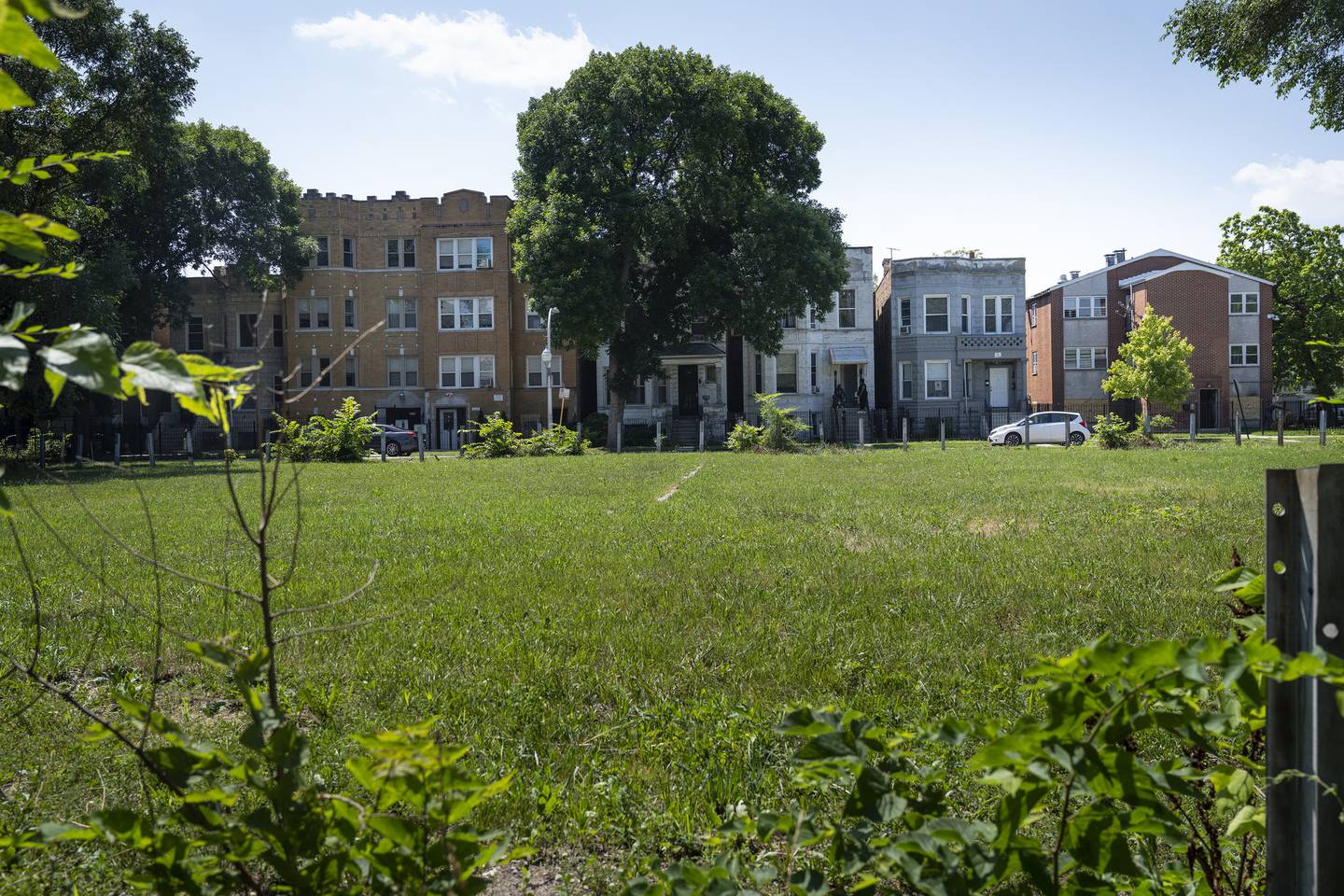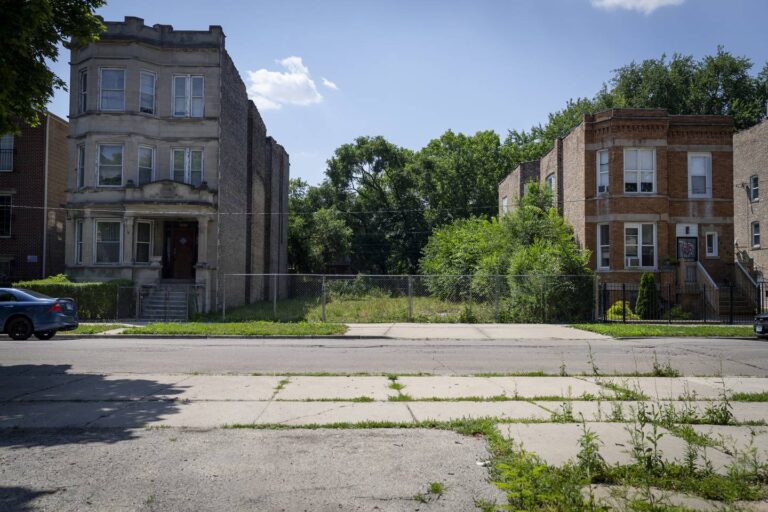Advertisement
Vacant and abandoned properties clustered on the Chicago’s South and West sides and southern suburbs have been a stubborn problem for decades. Every two years, the Cook County treasurer tries to return those properties to productive use during its biennial scavenger sale of delinquent taxes, often with little luck.
A new analysis from a team at Treasurer Maria Pappas’ office sought to find out why. Their answer: Federal “redlining” maps that sanctioned discriminatory lending policies in the late 1940s correlated strongly with sites of vacant and abandoned properties today.
Advertisement
The report, “Maps of Inequality: From Redlining to Urban Decay and the Black Exodus,” argues that those redlined maps “set in motion urban decay and fueled an ongoing exodus of Black people from Chicago and other major U.S. cities,” including Detroit and Philadelphia. The policy led to “vast swaths of vacant lots, abandoned homes and boarded-up businesses in minority neighborhoods” that existing tax laws and county programs do little to meaningfully address.
A March 2021 study from the University of Chicago’s Harris School of Public Policy found that since 2007, only 7% of all properties involved in the county’s scavenger sale were successfully returned to the private market. Meanwhile, the number of lots, homes and businesses on the scavenger rolls grew sevenfold, from about 4,000 in 2007 to more than 28,000 in 2019.
The study released Tuesday on the local impact of redlining — the systematic denial of home loans in minority neighborhoods on the grounds they were a bad risk — took close to a year to put together, with the help of nearly a dozen people in the treasurer’s office.
LaDale Winling, an associate professor of history at Virginia Tech who focuses on American urban and political history, including redlining, said the study “is a responsible and evocative way of illustrating that these processes and inequalities are not accidental, they don’t just happen, but in fact, they come about as a result of a long history of policy moves and actions that, frankly, an office like the Cook County treasurer should be reflecting on and thinking, ‘How do we reckon with this?’”
Properties make it to the scavenger sale chopping block when they have three or more years of unpaid taxes over the prior two decades. Private buyers can then make bids to acquire tax liens on such properties. If the original property owner doesn’t pay the taxes they owe — plus county interest fees that accumulate every month and possibly more if a private bidder buys a lien on those taxes — the bidder can eventually take ownership.
Pappas has been critical of the effectiveness of the scavenger sale for some time. But following this study, she proposes eliminating the sale entirely and building a new system that she argues would put those properties back on the tax rolls and into productive use in a faster and fairer way.
The study overlaid more than 27,000 distressed properties at risk of being sold due to delinquent taxes on top of the 1940 “security” map made by the federal Home Owners’ Loan Corp., or HOLC. A little more than half of the troubled properties fell within the 1940 map’s color-coded boundaries.
HOLC, which no longer exists, drew up maps that graded the prospects of mortgage lending in cities across the country. Red areas were deemed “hazardous,” due to lower rates of homeownership, poor housing conditions and an “undesirable population.” Yellow areas were “declining” in part because they were facing “infiltration of a lower grade population.” Blue and green were “still desirable” and “best,” respectively. HOLC reports referred specifically to the presence of Black, Jewish and non-English speaking people in the neighborhood as contributors to its undesirability.
Advertisement
Just because an area was redlined does not mean any one individual was rejected or denied for a mortgage, Winling pointed out, but the maps “gave the tools and changed the rules of the game” for private institutions like lenders, real estate appraisers and real estate agents to systematically discriminate.
Among the current scavenger sale properties that overlapped with HOLC maps, Pappas’ study found nearly all were in areas HOLC deemed undesirable: 57% were in red-mapped areas and 40% in yellow.
Sign up for The Spin to get the top stories in politics delivered to your inbox weekday afternoons.
The treasurer’s office tested the same hypothesis with about 8,500 distressed properties owned by the city of Chicago and found 98% were in red- or yellow-lined areas. So were 96% of the 5,600 properties owned by the Cook County Land Bank. Some areas, including in suburban Cook County, were rural at the time and not included in the HOLC map. But of the scavenger properties included in the 2022 sale, 93% were in areas with majority Black and/or Latino populations.
“Maybe the fundamental discriminatory idea behind redlining and the work of HOLC is that officials believed where African Americans lived,” there was an inherent risk of lower property values, Winling said. “Black-owned land was simply worth less and it should be treated as such.”
When Black families moved to areas that weren’t mapped by HOLC like the south suburbs, “they faced that same kind of ideology, structures of inequality and a withholding of support and services and so forth,” Winling said.
Advertisement
Those HOLC maps were precursors to other unfair lending and housing practices, argues Hal Dardick, the director of research in the treasurer’s office.
“You can look at other bodies of work and see how redlining led to contract sales, how it was compounded by segregation and racially exclusionary covenants out in the areas that were deemed better. Then when those things were outlawed — mostly in 1968 with the Fair Housing Act — other things took their places: subprime mortgages, regressive taxation and the undervaluing of real estate appraisals so many people in these communities can’t get loans adequate to purchase a home. … All these things ensue from when the federal government sanctioning redlining.”

To test their hypothesis, the treasurer’s office team conducted a similar analysis of Detroit, where distressed properties are largely owned by the city’s land bank authority. They found 85% of those were in red- and yellow-lined areas. Given Detroit’s steep population loss, though, it’s “more likely a home anywhere in Detroit would be vacant, abandoned or seriously tax-delinquent,” the report found.
In Philadelphia, where the city’s housing development corporation owns distressed properties, about 82% fell in redlined areas, and 15.5% in yellow-lined ones, the analysis found.
Pappas says the history of discriminatory lending has not only led to an exodus and likely exacerbates crime, but is hurting other taxpayers. When the owner of a property doesn’t pay, it pushes up the burden on everyone else in the county. Pappas says she wants to work with the city, the county land bank, the governor’s office and the state legislature to fix it.
“This is a ‘we’ problem, and we need to work on it, because if we don’t, (the tax rates of) people already paying taxes are going to go up because we haven’t solved the abandonment problem,” Pappas said.
Advertisement
The study makes 13 recommendations for reforms at the state and county levels. State lawmakers would need to approve making the scavenger sale optional in Cook County, rather than required. Pappas recommends reducing the redemption period for scavenger-eligible properties from 2 ½ years to one. That would require a change in the state constitution. She also proposes cutting the interest rate applied to delinquent property taxes in half, from 18% annually to 9%, and letting property owners make partial payments on the liens against their property, rather than a lump sum. The reforms wouldn’t come without a cost: If that interest rate were cut for the first 13 months of delinquency, the county would lose out on about $30 million in tax collections, Dardick said.
She also proposes that Cook switch to a model that nearly all other Illinois counties use: a trustee program.
That’s where counties obtain tax liens on properties not sold at their annual tax sales. If the property owner ends up paying their past-due bills, penalties and fees, the money is distributed to the county’s various taxing agencies. If the property owner does not pay up, the trust acquires title to the property, clears it of any liens and attempts to find a new owner through an auction, sale or giveaway. Proceeds of those sales would go to various taxing agencies as well.
This would be complicated in Cook, the report concedes, “because tens of thousands of properties can go without bids at tax sales held every year.”







